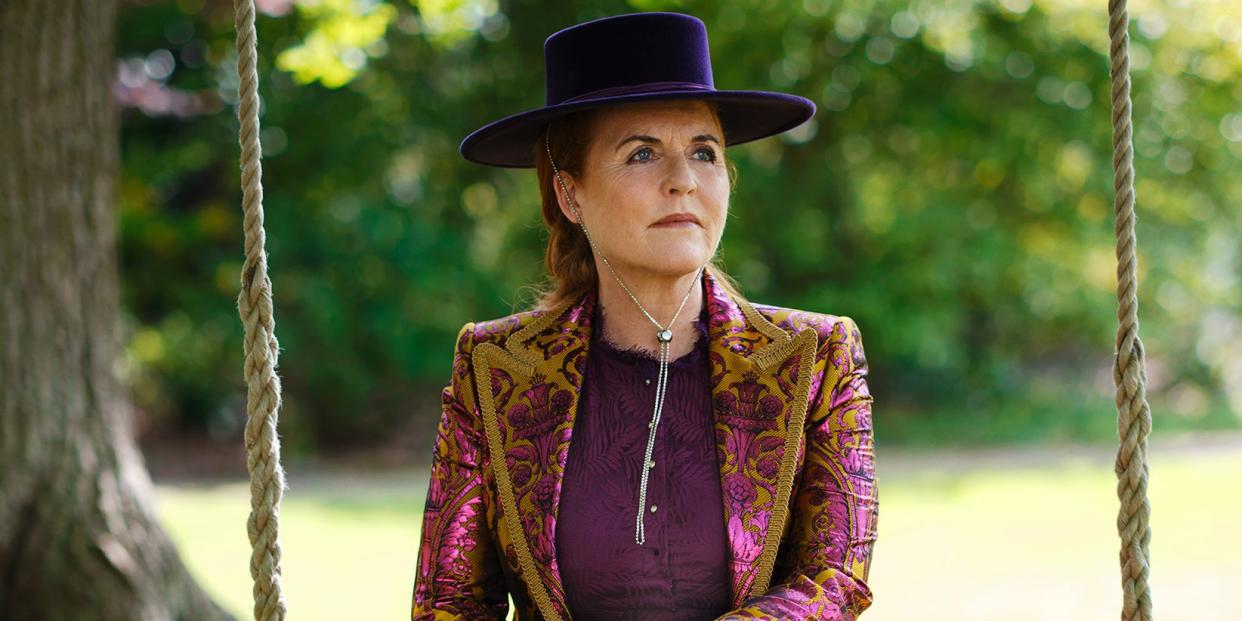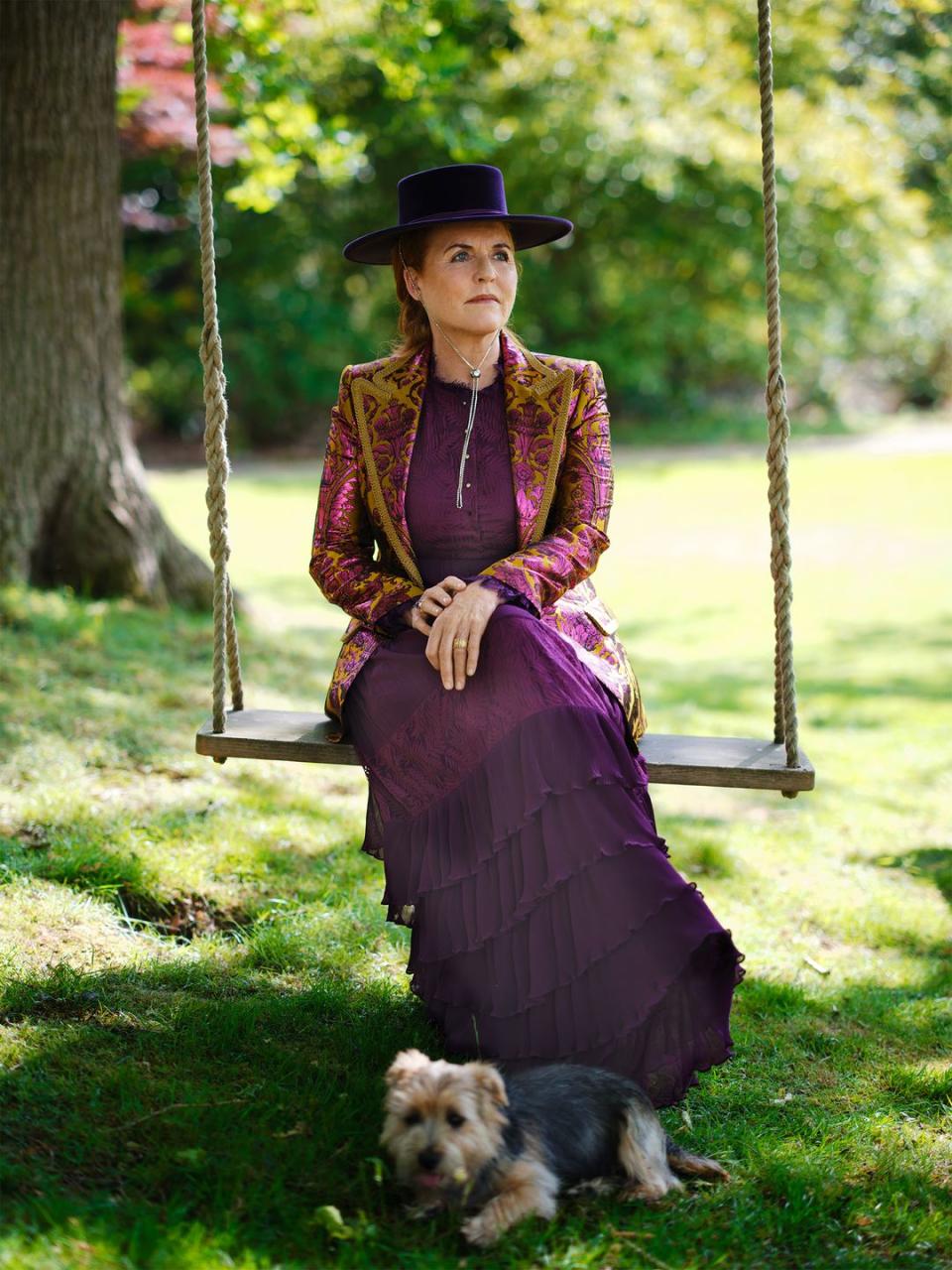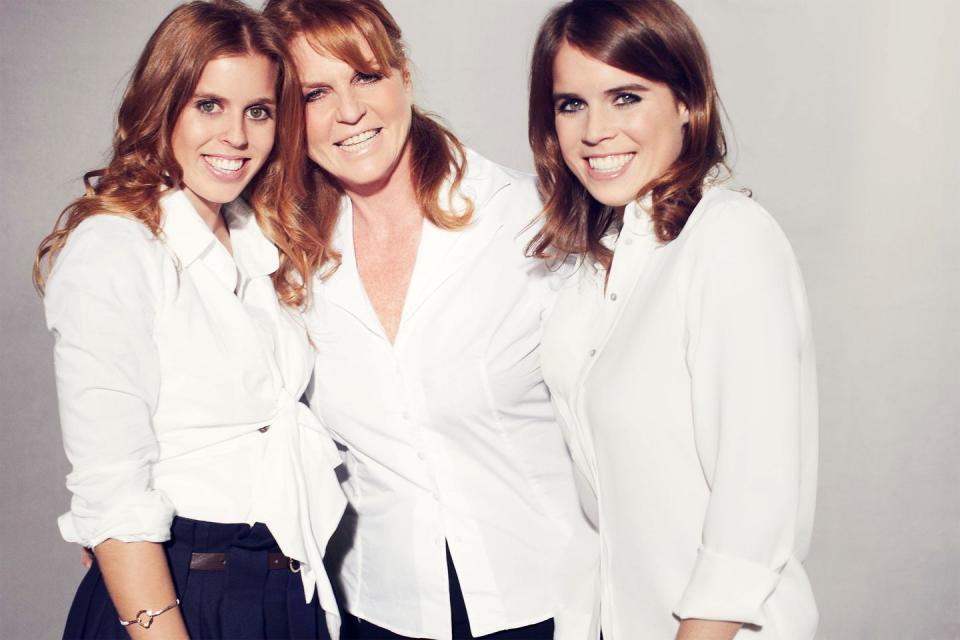Inside the Reinvention of Sarah Ferguson, the Ultimate Royal Rebel

“Hearst Magazines and Verizon Media may earn commission or revenue on some items through the links below.”

“Heavens, do you not regret anything you’ve done?” asks Sarah Ferguson, the Duchess of York. It’s a spring afternoon in England, and Ferguson is perched in a corner of Royal Lodge, the sprawling cottage orné built in 1662 that was once inhabited by King George IV and that she has shared with her ex-husband, Prince Andrew, since 2008.
Whether it’s just her tendency, as a self--described “people-pleaser,” or perhaps the aftershocks of Andrew’s disastrous 2019 Newsnight interview addressing his friendship with Jeffrey Epstein—a performance that ultimately cost him his role in British public life—Ferguson has left little to chance, choreographing elements of our Zoom interview, relying on off--camera assistants to present a variety of visual aids. “What I thought I’d do,” she says, “is that when you say, ‘Okay, so show us your latest project,’ I’d go, ‘Katie!’ We did boards for you in color.” And indeed, at various points in the conversation, young Katie slowly passes behind Ferguson hoisting an illustration, kind of like a boxing-ring girl in preppy clothes.
Ferguson looks fantastic. Over the years she has tried a variety of fashionable diets (one notably featured mayonnaise and mandarins) and traveled Europe seeking out the counsel of nutrition gurus, most recently Gianluca Mech, a proponent of herb extracts that supposedly supercharge the metabolism. She’s notably svelte, smartly turned out, her red hair freshly styled—perhaps a reaction to the decades of scrutiny she has experienced as a British tabloid fixture. “When they say you’re the ‘Duchess of Pork’ or you’re ‘frumpy Fergie,’ ” she says, “you start believing it.”

Ferguson speaks with a sense of detachment about the reckless Fergie of yore, whose last major publicity push, just over a decade ago, came after the admittedly profligate royal was caught on camera promising a News of the World reporter disguised as a sheik access to Prince Andrew in exchange for £500,000. She embarked on a series of media apologies, a pitiless book, and a TV series in which the likes of Oprah and Dr. Phil provided brutal diagnoses of her shortcomings. Suze Orman instructed her not only to cut up her credit cards, “she also said remove all the cuddly toys off my bed, which I still haven’t done,” Ferguson says, her distaste barely concealed.
Just the other day, she says, her media attorney, the defamation specialist Paul Tweed, told her, “I think you probably are the woman in the world who has had more bad front pages than any other,” which is saying something, considering that Tweed once represented Britney Spears. “I took it as a huge compliment,” she says. “I’m really proud that I’m still here.”
Whether it’s age, acquired wisdom, or the mellowing effect of becoming a grandmother—Princess Eugenie welcomed a son in February, and Princess Beatrice is expecting a baby this fall—-Ferguson seems to be a wiser, less combustible iteration of her former self. Today she has undeniable cultural cachet among her contemporaries and sentimental importance to the crown, the last female connection to the glamour of the 1980s. With Andrew, not she, occupying the royal doghouse, something that has happened only rarely in the 36 years since her childhood chum Princess Diana set them up, her sins now look penny-ante by comparison.
“It’s a very good moment, because I’m free,” Ferguson says. “She’s still with me, that person who thinks she’s fat, ugly, and disgusting, and she still has to have her hair done to talk to you, but she’s now not so vocal. The truth is, I am 61 years old and I’m free of the self--sabotaging Sarah.” But the famously saucy Sarah, whose dirty jokes supposedly thrilled Prince Philip when she married into the family, peeks out when I ask where exactly in her home she is currently situated. “This is a bedroom,” she says, then purrs, “I took you into my bedroom!” She cackles, then offers apologies to my wife.

The Fleet Street papers initially loved her raunchy edge but eventually decided it was more vulgar than charming. “It was always that Diana was portrayed as the saint and I was portrayed as the sinner,” she says. “Bad Fergie sold an awful lot of papers.” This new not-so-naughty Fergie, however, hopes to sell a lot of books. She’s about to release her first romance novel, Her Heart for a Compass, which is described as “a novel of the Victorian era” but is recognizable to close readers as more than that: part historical biography, part roman à clef, packaged safely in a fictional context.
The model for the novel’s heroine, Lady Margaret Montagu Douglas Scott, was actually the second daughter of the fifth duke of Buccleuch and his wife Charlotte, Ferguson’s great-great-great-grandparents. Scant details are known about Margaret, but the character in the novel hits familiar notes. She’s described as “Titian-haired,” with freckles and “rebellious curls,” and she is, to her detriment, “too anxious to please”; one suitor criticizes her for talking too much.
Just like Ferguson, Margaret is deemed by the press a breath of fresh air only to have the papers abruptly turn on her. Ferguson, following her separation from Prince Andrew and 1992’s infamous “toe sucking” photo scandal (which both she and her former financial adviser and lover, John Bryan, would clarify was but a toe kiss), fled to the U.S. to make her own way as a Weight Watchers spokesperson; Margaret makes a fictional journey across the pond to become a self-sufficient newspaper columnist. Margaret even writes a children’s book; Ferguson has written more than a dozen, and in 2020 she began a YouTube series, Fergie and Friends. While Margaret isn’t Ferguson per se, the duchess says, “I have thrown my voice into each line and I’m very proud.”
She partnered on the book with Marguerite Kaye, a prolific Scottish historical romance author, who found the duchess to be an active collaborator. “Right from the start it was clear she wasn’t going to be sitting in the back seat on this,” Kaye says. “She had a clear vision for what the story was that she wanted to tell, and she wanted to be involved in every stage of the process.”
Where Ferguson and her heroine part ways is in how they respond to expectations. The novel begins with an escape from a party. Rather than announce her engagement to a rich, titled dud, Lord Rufus Ponsonby, Lady Margaret bolts, an act that leads her father to disown her. Ferguson’s own royal suitor was no Lord Rufus; no one has ever claimed that her and Andrew’s courtship was anything but a true love story. But the union was freighted from the start. The reality of being married to the queen’s favorite son almost immediately inspired escape fantasies. Ferguson, crated in Buckingham Palace while Prince Andrew spent months at sea with the Royal Navy, was, she once wrote, becoming “a stiffly disciplined woman, drowning in duty.” Indeed, Margaret’s tale of independence might be interpreted as Ferguson’s fantasy of an independent road not taken. “Lady Margaret helped me become exactly the person who is talking to you right now,” she says.

Ferguson today is perhaps more conventional than anyone might have predicted. Her two prior books for adults were memoirs packed with a kind of oversharing that couldn’t have pleased the crown; even Diana, the expert tea spiller, reportedly stopped speaking to Ferguson after she revealed, in 1996’s My Story, that she had caught plantar warts after borrowing Diana’s shoes. Following her divorce, Ferguson was stripped of “her royal highness” but allowed to hold on to “Duchess of York.” As recently as 2011 she was excluded from the wedding of William and Kate, a decision she neither fought nor resented. “I didn’t think I was probably worthy to go to their wedding,” she says. “I took myself to Thailand, actually, to be far away from it so that I could try and heal.”
That Ferguson had reached a détente with the royal family was evident when she attended Prince Harry and Meghan Markle’s 2018 wedding, though today she seems to have taken the Firm’s side on the most divisive royal issue of the day: Megxit. In April, after Piers Morgan was forced to resign as host of Good Morning Britain for saying he believed that Markle was lying to Oprah Winfrey about racism and Buckingham Palace’s indifference to her suicidal thoughts, the TV host revealed that Ferguson had texted him support. There is, of course, great irony in this situation, given that Ferguson too was once deemed a mortal threat to the monarchy. (She refuses to comment directly on Megxit, only offering, “I believe that Diana would be so proud of her boys…and she’d be so proud of her grandchildren.”)

Her Heart for a Compass seems precision--engineered not to add to the Firm’s headaches. When Kaye was flown to London to first meet Ferguson, she was surprised to be summoned to Buckingham Palace for the meeting, which was attended by royal staffers taking notes. Regular romance readers may be surprised to find that in 549 pages not a single bodice is ripped. A couple of stolen kisses is as explicit as it gets, apparently in deference to historical sexual mores. “I decided I would remove bodice ripping from this book, number one," she says. "But I'm now on book number two with Marguerite…and I have got a real bodice ripping coming for you. This is going to make Fifty Shades of Gray just a walk in the park.” (Kaye pours some cold water on this. “She's teasing you,” she says.) Ferguson notes that her own life is now similarly chaste. “There is no romance,” she says.
It’s a far cry from the costume drama softcore of Bridgerton (which, along with The Bold Type and Riverdale, is among Ferguson’s favorite binges) or, for that matter, The Crown, in which she has barely been portrayed. “Hello?” she jokes. “Where is Fergie?” She even wrote to Andy Harries, an executive producer of The Crown, offering input. “I said to him, ‘Why can’t I help my character?’ ” she says. Her offer was declined.
If there’s one consistent theme in Ferguson’s story, it’s the disappointments and betrayals she has weathered—and her lack of rancor. Her mother abandoned her family to take up with a polo player in Argentina when Ferguson was 12; she died in 1998, leaving a mountain of debt. Ferguson’s onetime lover John Bryan peddled tales of their affair to the tabloids, and later her father wrote his own tell-all memoir. “I never read that book,” she says. “I felt that it would have been better that he hadn’t written it.” Though she once mulled suing him, she now won’t even celebrate the fall of Mazher Mahmood, the News of the World journalist who engineered that 2010 gotcha (and later spent 15 months in jail on unrelated charges). “One day I got up and thought, Mandela forgave his persecutors; surely I can forgive and move forward,” she says.
She’s known to be a loyal friend who won’t use news cycle vicissitudes as an excuse to duck obligations. Just before the pandemic struck, floral designer Eric Buterbaugh held a dinner to celebrate his 60th birthday. “It was during the time that Andrew wasn’t having the easiest go, but she was not going to miss it,” Buterbaugh says. “She came up to London, and that just shows how she suits up for friends… I’ve always said she’s like a Labrador retriever: She likes everybody, and everybody likes her.” Another pal, Howard Lutnick, CEO of Cantor Fitzgerald, underscores Ferguson’s empathy. She understands, he says, that “she married a prince, and god knows things are not perfect for her, so therefore it is just as unlikely that they are perfect for you.”
The one figure in Ferguson’s life with significant staying power is Prince Andrew, who has demonstrated similar devotion. “There is no question that we remain steadfast to each other in loyalty, integrity, honor,” she says, haltingly, when asked about his relationship with Epstein. Back in 2011 she dealt directly with the fact that she had accepted $24,500 from Epstein to help restructure her debts, remarking she was “just so contrite I cannot say,” a press strategy that might have saved her ex-husband’s reputation had he been half as proactive. “The family is everything to me,” she says. “The most important thing is the girls.”

The younger of Ferguson’s two daughters, 31-year-old Princess Eugenie, says that “my childhood and adult life have been made better by the spontaneity of my mother. She has managed to always give us the most fun and incredible upbringing. No is not a word in her language, so whenever we have had a conundrum, Mum is able to empower us to see it out the other side.” (Mum’s notable quirks? “She doesn’t like chocolate, which I’ve always found weird, but loves mackerel, which I’ve also always found weird.”)
There is no better image rehabilitation engine than time, and, recently, changing cultural attitudes have afforded some former tabloid punching bags sympathetic reassessments. Is it high time for Fergie to get one too? From the bedroom in the Royal Lodge, she ponders the question a moment. “I don’t want to say it’s going to be a reassessment of Fergie or a reinvention” she says. “Fergie is so steadfast that she will always be here.”
Photographs by Misan Harriman. Styled by Hannah Teare.
Hair by Jon Chapman at Nylon Artists for Dyson Hair & Oribe. Makeup by Lucy Halperin at the Wall Group for Tom Ford Beauty and REN Clean Skincare. Tailoring by Michelle Warner. Prodcution by KO Collective
A version of this story appears in the September 2021 issue of Town & Country.
You Might Also Like